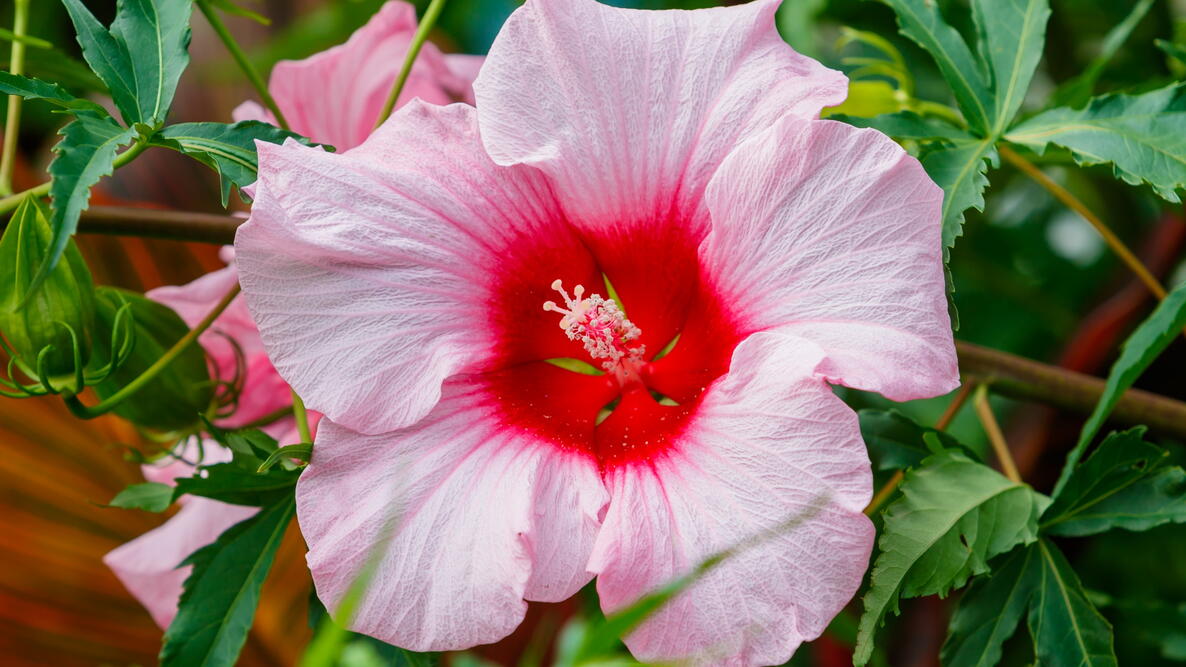
A Lady Baltimore Pink Hibiscus.
Planting, Growing, and Pruning Hibiscus
The Almanac Garden Planner - Use It Free for 7 Days!
Plan your 2025 garden with our award-winning Garden Planner.
Types
Scarlet Swamp Hibiscus (H. coccineus): This plant, also known as Texas Star, has 5-petaled, brilliant-red flowers. It grows to a height of seven feet each growing season, dies back to the ground every winter, and resprouts in spring.
Rose Mallow (Hibiscus moscheutos): This is the classic dinner-plate hibiscus due to the large size of its flowers. These large, fast-growing plants bloom from August to October, and each plant may flaunt several 10 to 12-inch wide flowers at once. A few of the many popular cultivars are:
- ‘Anne Arundel’ has pink flowers, nine inches in diameter, on plants five feet tall.
- ‘Kopper King’ has light pink to white flowers with a burgundy center, 12 inches in diameter, with coppery red deeply cut leaves.
- ‘Lady Baltimore’ is a popular old variety with pink flowers and red centers on five-foot-tall plants.
- ‘Lord Baltimore’ is another old variety with red flowers on five-foot-tall plants.
ADVERTISEMENT
My hibiscus has some yellow leaves what is this it has flours on as well. Help
In Arizona. When potting Hibiscus from local nursery, plants bud but do not open. Eventually plants fail to grow. Any suggestions. Occasionally leaves also turning yellow. Am I over- watering? Open to any suggestions. Is AZ too hot for hibiscus? Temp in triple digests for days at a time.
how to trim my plant its 12feet tall in a pot i should say when to trim
Hi Mary,
When grown outdoors in areas that can experience frost, hibiscus should be pruned in the spring after the the threat of frost has passed. Since it blooms on new wood (growth from that year) you should prune it before new growth begins to avoid pruning out that year’s flowers. If you live in an area with no frost, you can prune in the fall after the growing season has ended or for a much larger pruning project, you should wait until early spring.
If you plan to bring your hibiscus container indoors for the winter and display in a sunny window, you should prune it when you bring it indoors. If you plan to store it for the winter in a cool, dark location, like a basement or garage, you can wait until spring to prune.
Hope this helps!
My hibiscus has healthy green leaves and buds all over but they often die before they opening. It was almost dead when I bought the house. I trimmed it, watered and fertilized.
Same problem when re-potting. Buds do not open and drop off. Did you ever discover a solution?
I have 4 Hibiscus plants that I kept in the basement last winter and brought them out this spring. The plants have leaaves on them but are not blooming. What is wrong with them.
I have a hibiscus plant that hasn’t bloomed.What can I do?
Hi Nellie,
There can be a number of factors that will prevent your hibiscus from blooming.
Hibiscus need at least 6 hours of sunlight a day and lots of direct light promotes blooms, so too much shade can impact your plant. Hibiscus plants also have high water needs that should be on a schedule. An extended time without water can affect blooming, while too much water can as well. Water when the soil is mostly dry but still a bit damp because they do not like to dry out completely.
Fertilizing can also play a part because while used in the correct way it can allow your plant to thrive, it can also do the opposite if it does not get the right balance. (See above for fertilizing instructions.)
Depending on the age of your plant, pruning can also help but it may be a longer term solution. Just remember not to remove more than one-third of your plant at one time.
Hope this helps.
I have two rose mallow hibiscus that are over 6ft tall but have no flowers, not even buds. ?? This is the second year they have done this - grow like crazy but have no blooms. I fertilize, water, etc. What else can I do?










